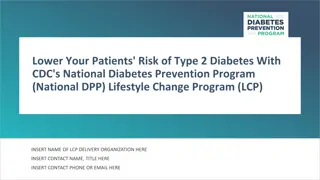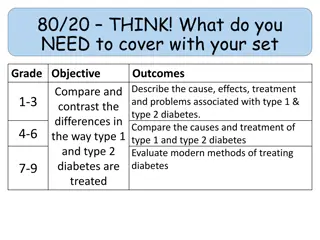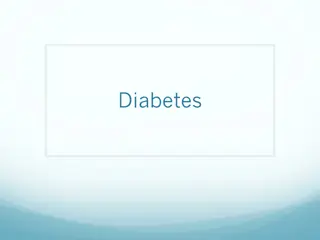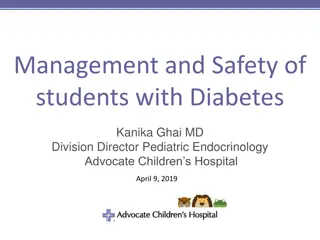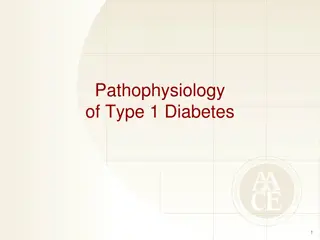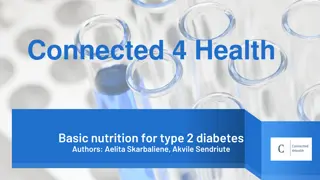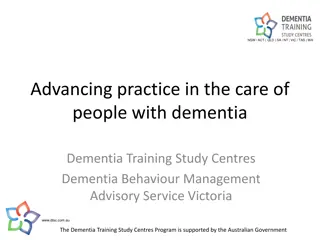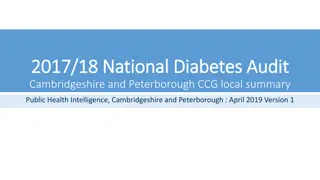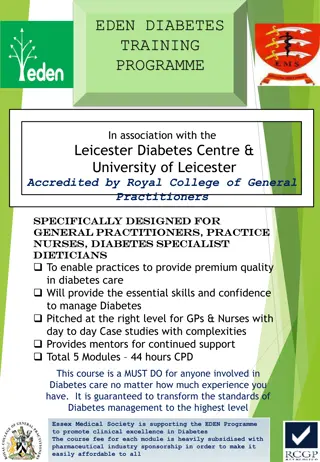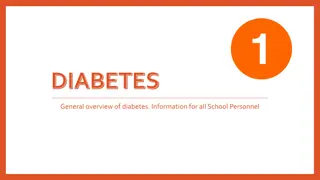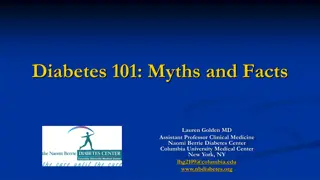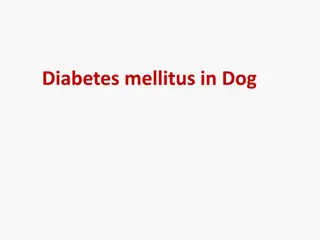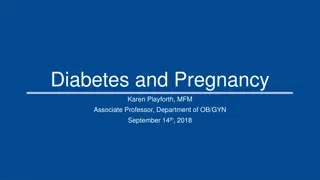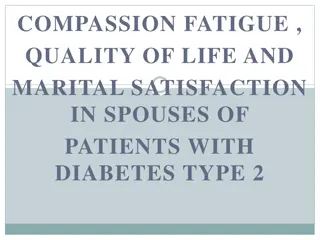Pharmacological Therapy for Type 2 Diabetes
Pharmacological therapy plays a crucial role in managing Type 2 Diabetes Mellitus (T2DM), focusing on treatment goals, principles, and case studies. It discusses treatment guidelines, goals, and different pharmacological options to control hyperglycemia effectively.
Download Presentation

Please find below an Image/Link to download the presentation.
The content on the website is provided AS IS for your information and personal use only. It may not be sold, licensed, or shared on other websites without obtaining consent from the author.If you encounter any issues during the download, it is possible that the publisher has removed the file from their server.
You are allowed to download the files provided on this website for personal or commercial use, subject to the condition that they are used lawfully. All files are the property of their respective owners.
The content on the website is provided AS IS for your information and personal use only. It may not be sold, licensed, or shared on other websites without obtaining consent from the author.
E N D
Presentation Transcript
In The Name Of GOD Pharmacological Therapy for T2DM Fatemeh Rahmani.MD Shahid Beheshti University of Medical Sciences
Treatment Goals for Adults with DM HbA1c <7.0% Pre-prandial blood glucose 80 130 mg/dL Post-prandial blood glucose <180 mg/dL HbA1c <6.5% Short duration of DM DM treated with lifestyle or Metformin only long life expectancy No significant CVD HbA1c <8.0% History of severe hypoglycemia Limited life expectancy Advanced micro or macrovascular complication Long standing DM in whom the goal is difficult to achieve
Goals of Therapy eliminate symptoms related to hyperglycemia eliminate the long-term microvascular and macrovascular complications allow the patient to achieve as normal a lifestyle as possible attention to the conditions associated with DM (obesity, HTN, dyslipidemia, CVD) Principles of Treatment Life style management (Nutrition Therapy, Physical Activity, Psychosocial Care) Diabetes self-management education and support Pharmacological treatment Surgical treatment
Pharmacologic Treatment of Diabetes A patient-centered approach Efficacy Hypoglycemia risk CVD,CHF CKD Impact on weight Cost Side effect Patient preference
Case 1 A 52-year-old woman known case of T2DM from 3 years ago was evaluated for management of DM. PMH: HTN, chronic stable angina, 2 times urinary tract infection in recent year DH: Metformin 2gr, losartan 50mg, HCT 25mg PH/Ex: BP:120/75 mmHg BMI: 24 Kg/m2 1+ pitting edema in lower extremities other review of system was unremarkable Lab test: FBS:155 mg/dl , HbA1c: 8.3% Cr: 0.9 mg/dl , LDL: 62 mg/dl
Which of the following should be added to control hyperglycemia? A) Tab Empagliflozin 25 mg/d B) Tab Gliclazide 60 mg/bid C) Tab Pioglitazone 30 mg/d D) Tab Acarbose 100 mg/d
Glucose-Lowering Agents Biguanide Insulin secretagogues: Sulfonylurea, Meglitinide Thiazolidinedione -Glucosidase inhibitor GLP-1 receptor agonist Dipeptidyl peptidase IV inhibitor Sodium-glucose cotransporter 2 inhibitor Insulin
Combination Therapy Combination Therapy Initial Dual therapy should be considered in patients with HbA1c >1.5-2 % above target Mild hyperglycemia (FBS <126 199 mg/dL) often respond well to a single, oral glucose-lowering agent Moderate hyperglycemia (FBS 200 250 mg/dL) usually require more than one oral agent
Glucose-Lowering Agents Biguanide Insulin secretagogues: Sulfonylurea, Meglitinide Thiazolidinedione -Glucosidase inhibitor GLP-1 receptor agonist Dipeptidyl peptidase IV inhibitor Sodium-glucose cotransporter 2 inhibitor Amylin agonists Insulin
Biguanide : Metformin Mechanism: reduces hepatic glucose production, improves peripheral glucose utilization Reduces FBS and insulin levels, improves the lipid profile Efficacy: High (1-2 % HbA1c reduction) Hypoglycemia: No Weight change: Neutral ASCVD: potential benefit CHF: Neutral Renal effect :adjusted in GFR<60 contraindicated in GFR<45 Side effect: GI intolerance(diarrhea, bloating, nausea) Vit B12 deficiency lactic acidosis
Tab Metformin (Glucophage) 500 mg-1000 mg BID Tab Metformin ER 500 mg-1000 mg BID Initial dose : 500 mg BID After 1-2 weeks increase to a maximally tolerated dose of 2000 mg/daily Contraindication moderate renal insufficiency (GFR <45 mL/min), acidosis unstable CHF liver disease severe hypoxemia hospitalized patients patients who can take nothing orally receiving radiographic contrast material
Glucose-Lowering Agents Biguanide Insulin secretagogues: Sulfonylurea, Meglitinide Thiazolidinedione -Glucosidase inhibitor GLP-1 receptor agonist Dipeptidyl peptidase IV inhibitor Sodium-glucose cotransporter 2 inhibitor Amylin agonists Insulin
Sulfonylureas First-generation (chlorpropamide, tolazamide, tolbutamide) have a longer half-life greater incidence of hypoglycemia more frequent drug interactions(warfarin, aspirin, ketoconazole, -glucosidase inhibitors, fluconazole) no longer used Second-generation sulfonylureas have a more rapid onset of action better coverage of the postprandial glucose rise shorter half-life of some agents may require more than once-a-day dosing Tab Glibenclamide 5 mg :2.5-10 mg/BID Tab Gliclazide 30,60,80 mg: 80-160 mg BID Tab Diamicron 30,60 mg/daidy
Sulfonylurea Reduce both fasting and postprandial glucose type 2 DM of relatively recent onset (<5 years) with residual endogenous insulin production Initiated at low doses and increased at 1-2 week intervals based on SMBG Efficacy: High (1-2 % HbA1c reduction) Hypoglycemia: Yes (delayed meals, increased physical activity, alcohol intake, Renal failure) Weight change: Gain ASCVD: Neutral Renal failure: Glibenclamide : not recommended Gliclazide : initiate conservatively to avoid hypoglycemia \ Cardioselctive Sus: glimepiride, gliclazide Contraindication : significant hepatic or renal dysfunction
Glinides Tab Repaglinide (Newbet) 0.5mg/1 mg/2mg : 0.5-2 mg/TID Tab Nateglinide 60-120 mg/TID Interact with the ATP-sensitive potassium channel Short half-life Immediately before each meal to reduce meal-related glucose excursions
Glucose-Lowering Agents Biguanide Insulin secretagogues: Sulfonylurea, Meglitinide Thiazolidinedione -Glucosidase inhibitor GLP-1 receptor agonist Dipeptidyl peptidase IV inhibitor Sodium-glucose cotransporter 2 inhibitor Amylin agonists Insulin
Thiazolidinedione Tab Pioglitazone 15 mg,30mg, 45 mg/d Reduce insulin resistance by binding to the PPAR- Raises HDL and LDL / decrease TG FDA recommends measurement of liver function tests prior to initiating therapy Efficacy: High (0.75-1.5% HbA1C reduction) Hypoglycemia: No Weight change: Gain (Promote a redistribution of fat from central to peripheral locations) CHF effect: increased risk Renal dose adjustment : not required Side effect: Fluid retention (Peripheral edema and CHF, reduction in hematocrit) Bone Fx, macular edema Contraindication : liver disease or CHF (class III or IV)
Glucose-Lowering Agents Biguanide Insulin secretagogues: Sulfonylurea, Meglitinide Thiazolidinedione -Glucosidase inhibitor GLP-1 receptor agonist Dipeptidyl peptidase IV inhibitor Sodium-glucose cotransporter 2 inhibitor Amylin agonists Insulin
- glucosidase inhibitors Tab Acarbose 25-50 mg TDS Reduce postprandial hyperglycemia Efficacy: Intermediate (0.5-1 % HbA1C reduction) Delay glucose absorption by inhibiting enzyme that cleaves oligosaccharides into simple sugars in the intestinal lumen Not affect glucose utilization or insulin secretion Initiation in low dose, evening meal, increased to a maximal dose over weeks to months Increase levels of sulfonylureas and increase the incidence of hypoglycemia In occurrence of hypoglycemia: consume glucose side effects : diarrhea, flatulence, abdominal distention Contraindication: IBD Gastroparesis Creatinine >2 mg/dL
Glucose-Lowering Agents Biguanide Insulin secretagogues: Sulfonylurea, Meglitinide Thiazolidinedione -Glucosidase inhibitor GLP-1 receptor agonist Dipeptidyl peptidase IV inhibitor Sodium-glucose cotransporter 2 inhibitor Amylin agonists Insulin
GLP-1 receptor agonist PEN liraglutide (Victoza, Melitide) 0.6 mg -1.2 mg-1.8 mg/ SQ/ d Increase glucose-stimulated insulin secretion Suppress glucagon Slow gastric emptying Used alone or as combination therapy with metformin, sulfonylureas, TZD Use of insulin secretagogues require a reduction in these agents to prevent hypoglycemia Short-acting GLP-1 RA: exenatide , lixisenatide provide mostly postprandial coverage Long-acting GLP-1 RA: liraglutide, exenatide, albiglutide, dulaglutide, lixisenatide reduce both the postprandial and fasting glucose
GLP1 agonist Efficacy: High (1-2 % HbA1c reduction) Hypoglycemia: No Weight change: Loss ASCVD: Benefit CHF: Neutral Cost: High Renal dose adjustment: Required Side effect: GI (nausea, vomiting, diarrhea) Acute pancreatitis Risk of MTC Contraindication: MTC, MEN syndrome, pancreatic disease
Glucose-Lowering Agents Biguanide Insulin secretagogues: Sulfonylurea, Meglitinide Thiazolidinedione -Glucosidase inhibitor GLP-1 receptor agonist Dipeptidyl peptidase IV inhibitor Sodium-glucose cotransporter 2 inhibitor Amylin agonists Insulin
DPP-4 Inhibitors Tab Sitagliptin (Ziptin, januvia) 50 mg, 100 mg: 25-100 mg/d Tab Linagliptin (Melijent ) 5mg/d Efficacy: Intermediate(0.5-1% HbA1C reduction) Preferential effect on postprandial blood glucose Hypoglycemia: No Weight change: Neutral ASCVD: Neutral Cost: High Renal dose adjustment: Required for Sitagliptin Not for Linagliptin Side effect: Acute pancreatitis Contraindication: pancreatic disease RF for acute pancreatitis ( heavy alcohol use, Hypertriglyceridemia , hypercalcemia)
Glucose-Lowering Agents Biguanide Insulin secretagogues: Sulfonylurea, Meglitinide Thiazolidinedione -Glucosidase inhibitor GLP-1 receptor agonist Dipeptidyl peptidase IV inhibitor Sodium-glucose cotransporter 2 inhibitor Amylin agonists Insulin
SGLT2 Inhibitors Tab Empagliflozin (Gloripa): 10 mg-25 mg/d Inhibits glucose reabsorption Lowers the renal threshold for glucose Increased urinary glucose excretion Glucose-lowering effect is insulin independent( Not related to changes in insulin sensitivity or secretion) Impair proximal reabsorption of sodium (diuretic effect) 3 6 mm Hg reduction in systolic blood pressure Inhibition of SGLT2 on alpha cell lead to increased glucagon and liver production of glucose and ketones
SGLT2 inhibitors Efficacy: Intermediate (0.5-1 % HbA1C reduction) Hypoglycemia: No Weight change: Loss ASCVD: Benefit CHF: Benefit Cost: High Renal dose adjustment: required Side effect: Euglycemic DKA (volume depletion, hypotension) Genitourinary infection Bone fractures Fournier gangrene
Combination Tablets Tab Sitagliptin-Metformin: 50-500 / QD,BID 50-1000/ QD,BID Tab Empagliflozin-Metformin: 5- 500 BID, 5-1000 BD 12.5-500 BID, 12.5-1000BID Tab Empagliflozin-Linagliptin : 10-5 /QD 25-5/QD Tab Linagliptin-Metformin : 2.5-500/QD,BID 2.5-1000/ QD,BID
Minimizing Cardiovascular risk initial use of Metformin GLP1 Agonist SGLT2 inhibitors Not advised Sulfonylurea and Insulin are increasing Cardiovascular risk Pioglitazone increase the risk of CHF
Minimizing Hypoglycemia older patients with a long duration of DM cognitive impairment neuropathy a prior history of hypoglycemia requiring assistance by another person Metformin doesn t cause hypoglycemia when used alone DPP4 inhibitors GLP1 agonists SGLT2 inhibitors TZD
Minimizing weight gain Diet and exercise Metformin as initial therapy GLP1 agonist SGLT2 inhibitors Surgical procedures Not advised Sulfonylurea TZD Prandial Insulin Basal insulin is less likely to cause weight gain than prandial
Minimizing cost Metformin Sulfonylurea Pioglitazone Acarbose Human insulin
Case 1 A 52-year-old woman known case of T2DM from 3 years ago was evaluated for management of DM. PMH: HTN, chronic stable angina, 2 times urinary tract infection in recent year DH: Metformin 2gr, losartan 50mg, HCT 25mg PH/Ex: BP:120/75 mmHg BMI: 24 Kg/m2 1+ pitting edema in lower extremities other review of system was unremarkable Lab test: FBS:175 mg/dl , HbA1c: 8.3% Cr: 0.9 mg/dl , LDL: 62 mg/dl
Which of the following should be added to control hyperglycemia? A) Tab Empagliflozin 25 mg/d B) Tab Gliclazide 60 mg/bid C) Tab Pioglitazone 30 mg/d D) Tab Acarbose 100 mg/d
Case 2 A 58-year-old woman is evaluated for management of type 2 DM. She has lost 3.2 kg by changing her diet and activity level. PMH: hypertension, hyperlipidemia, chronic stable angina. DH: aspirin, metformin, valsartan, metoprolol, atorvastatin PH/EX : BP :125/70 mmHg PR 74/min. BMI : 28 kg/m2 Lab test: HbA1c level: 8%, FBS 147 mg/dl eGFR 87%, Alb/cr ratio 15 mg/gr LDL 100 mg/dL
Which of the following should be added to control hyperglycemia and lower her risk of a major atherosclerotic cardiovascular disease event? A. Basal insulin B. Empagliflozin C. Gliclazide D. Sitagliptin



